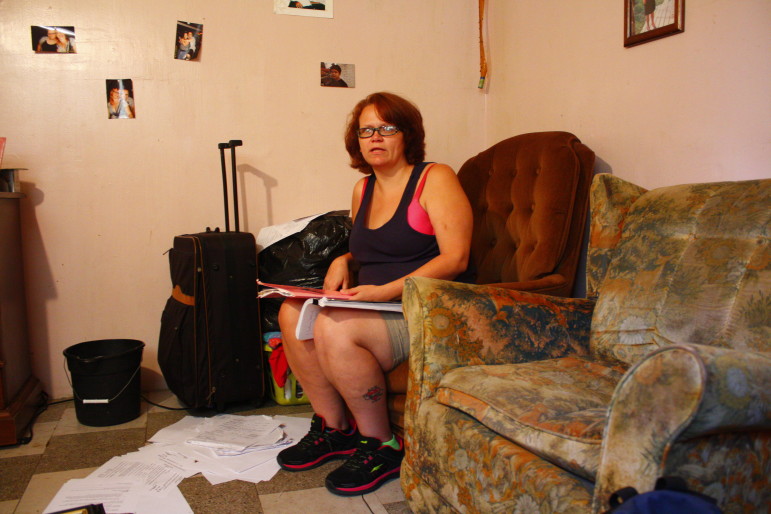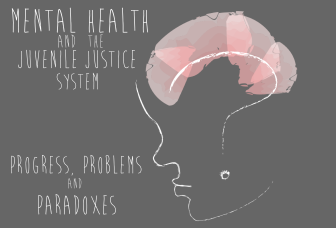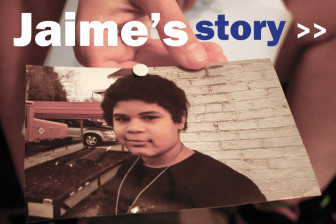
Susan Du / JJIE
Celia sits in her home with pictures of her son Jaime tacked on the wall behind her, pouring over records of his mental evaluations and court appearances. Celia says her son has been held at The Illinois Youth Center - Kewanee for a year and — despite multiple prior mental health diagnoses — has yet to be comprehensively assessed.
Editor's Note: This story is part of a series of articles exploring Mental health in the juvenile justice system and Community-Based Alternatives. Readers may also be interested in visiting the Juvenile Justice Resource HUB for more information.

Katy McCarthy / JJIE
Read more from the series: Mental Health and the Juvenile Justice System: Progress, Problems and Paradoxes.
The Illinois Youth Center - Kewanee, one of six juvenile detention facilities in the state, has since at least 2000 housed male youth with the greatest mental health needs. But the Kewanee facility has experienced difficulties for that entire time in finding adequate staff, in part due to its remote location, about two hours west of Chicago and away from major universities.
A September 2012 report from the John Howard Association, a watchdog group, found only eight of 17 authorized mental health positions were filled, and youth on average received only about 30 minutes of treatment per week. Also last September, the American Civil Liberties Union filed a lawsuit alleging the Illinois Department of Juvenile Justice (DJJ) did not provide “minimally adequate” mental health or education services, subjected youth to excessive amounts of solitary confinement, failed to protect youth from one another and held them beyond their release date due to a lack of adequate community placements.
The DJJ and ACLU entered into a consent decree in December to settle the lawsuit. Then, in March, the DJJ reduced special treatment units from 90 beds to 54 at Kewanee, and moved less acute, more long-term mental health cases to a facility in St. Charles, Ill., on the outskirts of the Chicago metropolitan area.
“The staffing levels [at Kewanee] are so abysmally low, they couldn’t possibly begin to provide the care that these kids not only need, but the state has promised them,” John Maki, director of John Howard, told the Juvenile Justice Information Exchange last spring.
DJJ Director Arthur Bishop said DJJ had been moving forward on improving staffing ratios and treatment amounts even before entering into the consent decree, although he acknowledges that the Kewanee facility has faced challenges. “Staffing has been a chronic problem in that community … even despite tremendous recruitment and marketing efforts,” he said. “That is not just limited to the treatment units — it’s psychologists, it’s social workers.”
 Among those impacted by the difficulty in providing care has been 14-year-old Jaime (his name has been changed for this article), whose mother, Celia, says her son has been held there for a year and — despite multiple prior mental health diagnoses — has yet to be comprehensively assessed. He receives individualized counseling just 30 minutes per week (Read more about Jaime’s story HERE)
Among those impacted by the difficulty in providing care has been 14-year-old Jaime (his name has been changed for this article), whose mother, Celia, says her son has been held there for a year and — despite multiple prior mental health diagnoses — has yet to be comprehensively assessed. He receives individualized counseling just 30 minutes per week (Read more about Jaime’s story HERE)
The department cannot speak publicly about individual cases, Bishop said, but when asked whether youths are ever held for that long without assessment, he responds: “I would wholeheartedly say, ‘No.’ ” Jennifer Jaworski, chief of mental health services, said youth receive “comprehensive, evidence-based” screening and assessment within their first two weeks in DJJ, starting with the Massachusetts Youth Screening Instrument (MAYSI).
“Special treatment youth would not be at Kewanee unless they had been assessed to go there,” she said. The 30 minutes of individualized counseling sounds accurate, she said, although that’s supplemented with several hours of group therapy.
The next steps under the consent decree will come next month, when the Illinois DJJ will hear suggestions on how to improve services within its facilities from a number of experts, including a mental health team led by Dr. Louis Kraus, chief of child and adolescent psychology at Rush University Medical Center. Those reports are scheduled to be released Sept. 9 and discussed during a court “status meeting” on Sept. 16.
“The experts have been investing a great deal of time and energy investigating services at DJJ facilities, visiting facilities, talking with executives, interviewing staff, reviewing documents, interviewing youth. And now they are writing their report,” said Adam Schwartz, lead counsel for the ACLU, adding that he is “not at liberty to describe” until after Sept. 9 what the experts were finding.
Questions of Due Process
Responding to Celia's claims, retired Chief Circuit Court Judge George Timberlake, who leads the Illinois Commission on Juvenile Justice, said a youth being held for a year without an assessment would be “an outlier” as far as he knows. “I can’t testify first-hand,” he said, but “if that’s typical, that’s shocking.”
Having said that, Timberlake adds that, although DJJ has moved forward in implementing mental health screening and assessment tools, “The mental health response is inadequate because of the difficulty of hiring mental health professionals. They continue to have difficulty hiring staff at Kewanee. They’ve hired some, but not enough.”
Betsy Clarke, president of the Juvenile Justice Initiative, said she visited St. Charles recently, and youth in custody were receiving “three hours a day, a few days a week” in school, and she would be surprised to hear that a youth like Jaime receives even 30 minutes per week of counseling.

Susan Du / JJIE
Celia stands outside her home in Harrisburg, where she lives with her mother, Kathy Hammons. Of Hammons' $700 monthly Social Security check, $400 goes to rent, leaving barely enough for other expenses and nothing at all for Celia to travel to Kewanee to see Jaime.
“One of my staff was just in Kewanee and said it’s absolutely inadequate,” Clarke said. “There are still concerns about harsh discipline tactics — forget the sexual victimization — the use of solitary confinement and so forth. You’ve got kids with not enough to do. You’ve got staff not equipped to provide programming … And you’ve got kids who would be better off not being there, but in the community with wraparound programming.”
But, Clarke said, “there’s no due process” when it comes to how long youth should be held. “The director [Bishop] never talks about it in terms of, ‘as short a time as possible,’ ” she said. “He talks about it in terms of completing a treatment plan. Well, there’s no treatment. There’s not even education.”
DJJ says it’s been moving forward on those issues, pointing to the reduction of 36 special treatment beds in Kewanee as a start. The shift of those chronic mental health cases to the St. Charles facility has not increased the overall population there — there are still 48 beds — because of the lower overall caseload throughout DJJ, Jaworski said.
The staffing ratios for juveniles classified as needing mental health or substance abuse treatment are one staff per six youth; while the ratios for those needing acute special treatment have fallen from 1:18 to 1:9 and for sex offenders from 1:24 down to 1:18.
“Those are right in line with what best practices would say are appropriate,” Jaworski said. Although a net of “one or two” staff have been hired, she said, most of the improvement in ratios has come from reducing the special treatment population.
Special treatment youth receive four to five hours of group therapy per week, up from two hours prior to recent reforms, as well as 30 minutes of individual therapy, Jaworski said. Juvenile sex offenders receive three to four hours of group therapy per week, up from 30 minutes previously.
Bishop says the department’s average stay is between six and nine months and that due process consist of individualized youth development plans—not “one size fits all”—that “effectively prepare them for discharge and re-entry into their community. We’re focusing on individualized plans based not on dysfunction but on the strength and assets of the youth.”
Maki said he’s noted the movement of youth out of Kewanee and into St. Charles, where presumably it could be easier to attract needed mental health professionals given its proximity to a major metropolitan area. “Based on our work, mental health continues to be a real challenge for the Department of Juvenile Justice,” Maki said. After closures of two facilities, in Joliet and in Murphysboro, “What the DJJ is working on right now is, ‘How do you use the facilities you have to treat the population you have?’ ”

Susan Du / JJIE
A letter Jaime sent from prison gave Celia hope even in the days after his incarceration when her hair was falling out with worry.
The overall increase in population at Kewanee has come largely from youth who had been housed in the now-closed facility in Joliet, which has made the dynamic more complex, he said.
“Many of the kids who were at Joliet were the most difficult kids,” he said. “Now, they’re further away from their families … Kewanee is going to require special attention going forward. I don’t think the long-term answer is to have one facility deal with all the most difficult kids, especially one that has historically struggled with resources.”
DJJ only has so much control over the larger picture, Maki emphasized. “They get who gets sent to them,” he said. “With the erosion of community health treatment, often from a lack of funding, you’re seeing the most difficult kids still getting sent to DJJ. Arguably, they belong in a mental health setting.”
Bottom line, DJJ took significant steps forward in closing the Joliet and Murphysboro facilities and “right-sizing the system,” Maki said. “Now the second part begins. Let’s see. I think it will be awhile before we know what’s working and what’s not working.”
Schwartz said the ACLU was “100 percent supportive of the closures,” but he isn’t entirely sure where all the youth housed in Joliet and Murphysboro ended up. The Kewanee facility is divided into two sets of buildings, so that “by design, it’s capable of having two sets of kids who never really see each other that much.”
But there are now three different populations in Kewanee. In addition to the special treatment population of 54, DJJ records show that Kewanee currently houses 84 juvenile sex offenders and 121 maximum security offenders; the latter group are housed on one side of the facility, separate from the rest.
Although the special treatment and sex offender populations are on the same side of the facility, DJJ says they only mix during meals, and then only briefly when one population is being escorted in while the other is escorted out.
Federal Sexual Abuse Report
Heaped onto DJJ’s plate in the coming months and years is the issue of sexual abuse in youth prisons. While nothing new, the subject has taken on new urgency since the release in June of the federal Bureau of Justice Statistics report naming Illinois among four states, along with Georgia, Ohio and South Carolina, that reported the highest rates of victimization in juvenile facilities in 2012.
Nationwide, an estimated 9.5 percent of adjudicated youth reported such incidents, but in Illinois, the figure topped 15 percent in the survey, conducted in 273 state-owned or -operated juvenile facilities and 53 locally- or privately-operated facilities with state contracts. The survey is required under the Prison Rape Elimination Act.
Timberlake isn’t at all surprised by the notion that some amount of sexual abuse would be taking place in a correctional facility. “But it was genuinely shocking, the number, percentage and rate,” he said. “They [DJJ] were shocked also. Should they have been? I don’t know.”
Clarke sees the need for an inspector general or ombudsperson who would be completely independent of DJJ, have 24-7 access to facilities and be able to make systemic recommendations to the Legislature. “It’s a concern since there’s been so much effort since 2006 to turn these into more therapeutic and less correctional facilities,” she said.
Maki said his organization was “shocked” at the findings when they first came out, given that they regularly monitor DJJ, talk with staff, youth and families, and “we had never heard stories like this before.” He added: “We were trying to figure out why we didn’t know this. DJJ felt the same way.”
“It’s very concerning,” Bishop said of the federal report. “Any level of abuse, whether sexual abuse or physical abuse is concerning.” He said the department certainly has discharged staff for such abuses, and he believes the “rightsizing” of the department that Maki references will help to shine a spotlight on them going into the future.
DJJ is working with the state Department of Children and Family Services to jointly implement a 24-hour hotline for youth who are victimized, and the department is also thinking about establishing an ombudsman, as Clarke suggested, who would operate independent of the department but on site, to monitor the situation.
The department in August brought in former FBI special agent Kathleen McChesney, now a Los Angeles-based management consultant, to analyze and assess the department’s policies and practices. McChesney and other experts are interviewing staff, youth and other stakeholders to figure out why the DOJ report cited higher figures than facilities themselves had been reporting.
“We’ve alerted and educated and orientated the youth who are in place here,” Bishop said. “We’re collaborating with the John Howard Association—they’re a watchdog group, that’s not a usual arrangement—but we’re working with them so they can assist in educating and orientating the youth, and also parents, around the use of the hotline, and also giving them another opportunity to have a voice.”
The federal report underscores the need — already recognized separately due to the difficulties caring for those who need mental health — to reduce population in juvenile detention facilities and make them more youth-focused and treatment-focused rather than punitive, Maki said.
“This is the future of juvenile justice reform,” he said. “How do you become less reliant on incarceration? Secondly, if you use residential facilities to hold youth, how do you uphold the fundamental tenet that you should treat youth differently from adults and return them safely to their communities?”
“We don’t want the DJJ to be a de facto treatment program,” Bishop said. “Local county judges may send youth to us because we have programs, but we don’t want that. And judges are moving away from that now. If you look at the admission of youth who come to us, they come with a tremendous lack in all of those areas—education, health care, mental health services. In many cases they’re getting better care in our facilities. Although we’re not satisfied with where we are.”

